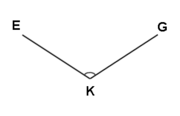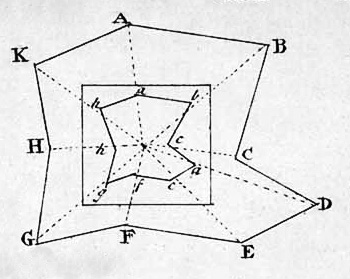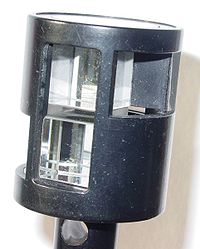
Circumferentor
Encyclopedia

Surveying
See Also: Public Land Survey SystemSurveying or land surveying is the technique, profession, and science of accurately determining the terrestrial or three-dimensional position of points and the distances and angles between them...
to measure horizontal angles, now superseded by the theodolite
Theodolite
A theodolite is a precision instrument for measuring angles in the horizontal and vertical planes. Theodolites are mainly used for surveying applications, and have been adapted for specialized purposes in fields like metrology and rocket launch technology...
. See also alidade.
It consists of a brass circle and an index, all of one piece. On the circle is a card, or compass
Compass
A compass is a navigational instrument that shows directions in a frame of reference that is stationary relative to the surface of the earth. The frame of reference defines the four cardinal directions – north, south, east, and west. Intermediate directions are also defined...
, divided into 360 degrees; the meridian line of which is in the middle of the breadth of the index. On the circumference of the circle is a brass ring, which, with another ring fitted with glass, make a kind of box for the needle, which is suspended on a rivet in the center of the circle. On each extreme of the index is a sight
Sight (device)
A sight is a device used to assist aligning or aim weapons, surveying instruments, or other items by eye. Sights can be a simple set or system of markers that have to be aligned together as well as aligned with the target...
. The whole apparatus is mounted on a staff, with a ball-and-socket joint for easy rotation.
Circumferentors were made throughout Europe, including England, France, Italy, and Holland. By the early 19th century, Europeans preferred theodolite
Theodolite
A theodolite is a precision instrument for measuring angles in the horizontal and vertical planes. Theodolites are mainly used for surveying applications, and have been adapted for specialized purposes in fields like metrology and rocket launch technology...
s to circumferentors. However, in America, and other wooded or uncleared areas, the circumferentor was still in common use.
Usage


Measuring angles
To measure an angle with a circumferentor, such as angle EKG (Figure 1), place the instrument at K, with the fleur-de-lisFleur-de-lis
The fleur-de-lis or fleur-de-lys is a stylized lily or iris that is used as a decorative design or symbol. It may be "at one and the same time, political, dynastic, artistic, emblematic, and symbolic", especially in heraldry...
in the card towards you. Then direct the sights, until through them you see E; and note the degree pointed at by the south end of the needle, such as 296°. Then, turn the instrument around, with the fleur-de-lis still towards you, and direct the sights to G; note the degree at which the south end of the needle point, such as 182°. Finally, subtract the lesser number, 182, from the greater, 296°; the remainder, 114°, is the number of degrees in the angle EKG.
If the remainder is more than 180 degrees, it must be subtracted from 360 degrees.
Surveying a region
To take the plot of a field, forest, park, etc, with a circumferentor, consider region ABCDEFGHK in Figure 2, an area to be surveyed.- Placing the instrument at A, the fleur-de-lis towards you, direct the sights to B; where suppose the south end of the needle cuts 191°; and the ditch, wall, or hedge, measuring with a Gunter's chainEdmund GunterEdmund Gunter , English mathematician, of Welsh descent, was born in Hertfordshire in 1581.He was educated at Westminster School, and in 1599 was elected a student of Christ Church, Oxford. He took orders, became a preacher in 1614, and in 1615 proceeded to the degree of bachelor in divinity...
, contains 10 chains, 75 links. - Placing the instrument at B, direct the sights as before to C; the south end of the needle, e.g. will cut 279°; and the line BC contains 6 chains and 83 links.
Then move the instrument to C; turn the sights to measure D, and measure CD as before. In the same manner, proceed to D, E, F, G, H, and lastly to K; still noting the degrees of every bearing, or angle, and the distances of every side. This will result in a table of the following form:
| Station | Degrees | Min. | Chains | Link |
|---|---|---|---|---|
| A | 191 | 00 | 10 | 75 |
| B | 297 | 00 | 6 | 83 |
| C | 216 | 30 | 7 | 82 |
| etc. | ||||
From this table, the field is to be plotted, or protracted.
Surveyor's double prism

Plumb-bob
A plumb-bob or a plummet is a weight, usually with a pointed tip on the bottom, that is suspended from a string and used as a vertical reference line, or plumb-line....
. it is used to stake out right angle
Right angle
In geometry and trigonometry, a right angle is an angle that bisects the angle formed by two halves of a straight line. More precisely, if a ray is placed so that its endpoint is on a line and the adjacent angles are equal, then they are right angles...
s, for example on a construction
Construction
In the fields of architecture and civil engineering, construction is a process that consists of the building or assembling of infrastructure. Far from being a single activity, large scale construction is a feat of human multitasking...
site.

